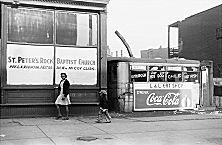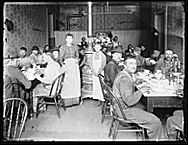| Entries |
| F |
|
Foodways
|

|
At the other end of the epicurean spectrum, the city's turn-of-the-century fine dining establishments also practice culinary transnationalism. Charlie Trotter's helped cement Chicago's reputation as one of the United States' restaurant meccas by winning multiple international awards for its “fusion” food, amalgamating global ingredients into creative dishes inspired by the city's architecture in both form and presentation. Surrounding Trotter in Chicago's culinary constellation were Rick Bayless's upscale Mexican Frontera Grill and Topolobampo, Arun's Thai cuisine, and a bevy of chic establishments serving every kind of international cookery, from Moroccan to Japanese to “pan-Latin.”
All this does not necessarily represent anything new for Chicago's food scene. The city's ongoing roles as destination for migrants and major food distribution center have always placed food squarely at the center of Chicago's history and culture. The city's very existence was generated in the mid-nineteenth century by the exchange of commodities between the food producing regions of the rural Midwest and West and the hungry masses of the burgeoning nation.
As meat, grain, European immigrants, and American businessmen flowed into nineteenth-century Chicago, the city's taste for eating options varying in both price and ethnic diversity became clear. Fine dining establishments eschewed the city's gritty image by emphasizing Continental cuisine and service, importing oysters and lobster from the East, and comparing themselves favorably to New York's best. By the early to mid twentieth century, prompted by cultural trends toward “exoticism” and the growing numbers of immigrant businesspeople entering the fine dining market, the city's tonier watering holes began advertising their Chinese and Italian chefs and menus alongside their Continental and East Coast credentials.

|
Meanwhile, the city's development from a commodity crossroads to a major industrial metropolis necessitated the growth of more modest food businesses to serve employees of the factories and stockyards. While home cooking continued to be most people's main source of sustenance, supported by neighborhood grocery stores, street peddlers, community gardening, and even livestock raising, the women who were largely responsible for this work were limited by tenement kitchens and work schedules that often failed to coincide with normal family mealtimes. As a result, large numbers of working-class Chicagoans ate out at neighborhood cafés, taverns, and lunch counters. These places reflected their patrons' ethnicities and cultural backgrounds. Many served as meeting places for union organizers and social clubs, employment and travel agencies, message centers, and informal banks. This custom continued into the twenty-first century in food businesses owned by new immigrants from places as diverse as Pakistan, Ethiopia, and Jamaica.
All of Chicago's neighborhoods and immigrant groups have contributed in their own way to a rich food culture in the metropolitan area. A case in point is the Italian food business community. Beginning in the 1850s, immigrants from Genoa entered Chicago's food business, as they did in other major American urban centers. Originally, they opened shops in the diverse wholesale markets ringing the city, relying on a network of Italian friends, relatives, and business partners who owned farms and transportation companies across the United States. Within 40 years, although Italians accounted for less than one percent of Chicago's population, they owned one-quarter of its fruit businesses and one-fifth of its restaurants. Of the 6,773 Italians living in Chicago in 1896, the Chicago City Directory listed 22 Italian saloonkeepers, 154 fruit merchants, 32 grocery store owners, and 38 confectioners, as well as several of the city's most respected fine dining establishments. By 1927, a survey of the Chicago Telephone Directory indicated that Italians owned no fewer than 500 grocery stores, 257 restaurants, and 240 pastry shops around the city, as well as numerous bakeries, delicatessens, fruit wholesalers, cafés, and pasta and cheese shops. Although these businesses were concentrated in Italian neighborhoods, they served other Chicagoans too. By the 1920s, non-Italian Chicagoans had discovered Italian food and helped to make it the most popular “ethnic” cuisine in America. Italian restaurants, and the generations of families that owned them, continued to play substantial roles in Chicago's food scene into the twenty-first century.

|
The Encyclopedia of Chicago © 2004 The Newberry Library. All Rights Reserved. Portions are copyrighted by other institutions and individuals. Additional information on copyright and permissions.